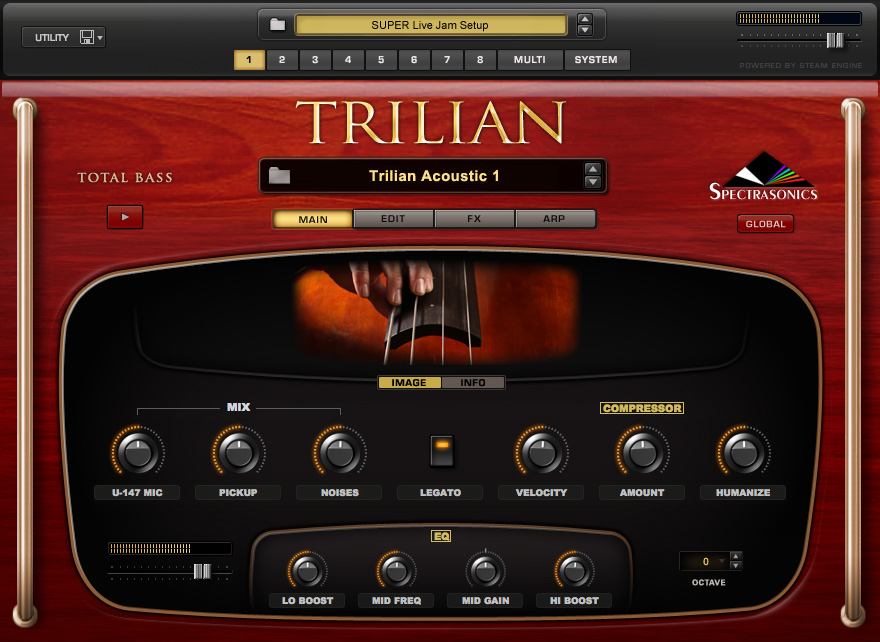Spectrasonics Trilogy Total Bass Module Torrent

Oct 31, 2016 - Spectrasonics – Trilogy 1.00 (VST) [Win x86]. World's first and only virtual instrument dedicated as a total solution for Bass – integrating a. Form within our current Bass module, Trilian – which is based on our STEAM engine. Contec abpm 50 driver reviews.
Trilogy is big on bass — its supplied library has 3GB of sounds! Is it sweet and low, or does it plumb new depths? Appropriately enough, Spectrasonics' Trilogy is the company's third virtual instrument, but the name actually relates to the number of sound types covered by the product, which is dedicated to reproducing bass sounds. The categories are acoustic bass, electric bass and synth bass, and like Stylus and Atmosphere before it, the core sample library is around 3GB in size and comes spread over five CD-ROMs. As with the other two instruments in the series, the core sounds are based on completely new samples, and there's no provision to import your own samples, though future upgrades could add new sounds. Designed to work as a VST 2.0 plug-in (also supporting OS 9 MAS, and RTAS), future upgrades to Trilogy are planned to support RTAS and VST and Audio Units under OS X, while Sonar users can employ a VST-DXi wrapper to make use of the VST 2 version. MOTU will be supporting Audio Units under OS X, so it is anticipated that there will be no need for an OS X MAS version.
Spectrasonics Trilogy £189 pros • Blindingly good electric and acoustic bass sounds with lots of little frills to make them sound more realistic. • Complete armoury of all the analogue synth bass sounds you could wish for, plus the means to modify the presets or create your own sounds using raw waveforms.
Cons • LFO's not sync'able. • Some audible aliasing when using the waveforms as high-pitched lead sounds.
Summary If your music has a bass line (and what music doesn't?) and you can use VST instruments, then Trilogy is about as close to an essential as it gets. A powerful computer is essential to make serious use of Trilogy (though less than Atmosphere, as bass sounds tend to use less polyphony); as well as needing over 3GB of free hard drive space, you'll also need plenty of free RAM, as some of the sample sets are pretty large. Spectrasonics recommend that you have around 512MB of RAM reserved for Trilogy, though most sample sets seem to be under 200MB in size. The recommended minimum computer specs are a 300MHz Pentium III PC (running Windows 98, 98SE, ME, 2000 or XP) or a 300MHz Mac G3 (OS 9.04 to OS 9.2.2). Both installation and operation were trouble-free on my Mac G4 (for the spec, see the box on the next page). A proprietary copy-protection method is used, which works on a challenge/response system. Web address details are included in the manual and once you enter your serial number and challenge code, the response is immediate.
Prior to authorisation, you can use Trilogy for just 48 hours. As with the other Spectrasonics products, the licensing arrangement is similar to that for CD-ROM samples, the main restrictions being that you can't make a commercial sample library using the instrument, you can't re-sell Trilogy and only the owner is licensed to use it.
The core library of over 13,000 individual samples covers electric basses (including fretless, picked, fingered and slapped models), acoustic basses and a huge range of synth basses. Additionally there's a large library of classic synth waveforms so that you can use Trilogy's modulation functions, filters and envelope-shapers to build your own synth patches. Trilogy is based around a customised UVI audio playback engine with a straightforward, synth-like front panel which is (aside from a few minor cosmetic details) identical to that of Atmosphere. Sounds are comprised of one or two layers, A and B, and one set of controls is used that can be switched between the two layers using the A and B buttons in the centre of the panel. The relative levels of the layers can be balanced with the A and B mixer sliders on the left of the panel, and buttons in the centre select which layer is currently being edited. A Link button enables both layers to be adjusted together.
There are separate envelope-shapers for level and filter with a choice of filter modes, and there's a master filter controlled by a slider that can be either high-pass or low-pass depending on which side of the centre position the fader is set. The sounds are loaded from the hard drive into RAM via a menu window in the centre of the panel where the sounds are categorised and then further sub-categorised. A patch comes up with the one or two sample sets it requires plus all the control settings, though you can can create your own patches by loading any of the individual sample sets into either layer and then setting the controls appropriately. In addition to the layer level controls, separate pan controls are provided for both the A and B layers as well as controls for coarse and fine tuning. As on Atmosphere, the modulation section hosts four variable separate LFOs where the modulation destination possibilities are pitch, filter, amplitude and pan. LFOs 1 and 2 are independent for each layer and always start in phase with the Note On message, while LFO 3 and LFO 4 are global and free-running. Also as with Atmosphere, the LFO's can't currently be sync'ed to tempo.